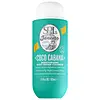What's inside
What's inside
 Key Ingredients
Key Ingredients

No key ingredients
 Benefits
Benefits

 Concerns
Concerns

 Ingredients Side-by-side
Ingredients Side-by-side

Water
Skin ConditioningSodium Cocoyl Isethionate
CleansingGlycerin
HumectantSodium C14-16 Olefin Sulfonate
CleansingCocamide Mipa
EmulsifyingCocamidopropyl Betaine
CleansingParfum
MaskingSalicylic Acid
MaskingLactic Acid
BufferingSalix Alba Bark Extract
AstringentCarica Papaya Fruit Extract
Skin ConditioningMusa Sapientum Pulp Extract
Skin ConditioningMangifera Indica Pulp Extract
Skin ConditioningSpondias Mombin Pulp Extract
Skin ConditioningCorallina Officinalis Extract
Skin ConditioningMelia Azadirachta Leaf Extract
Skin ConditioningMelia Azadirachta Flower Extract
Skin ConditioningCoccinia Indica Fruit Extract
Skin ConditioningSolanum Melongena Fruit Extract
Skin ConditioningAloe Barbadensis Flower Extract
EmollientOcimum Sanctum Leaf Extract
Skin ConditioningCurcuma Longa Root Extract
MaskingCoconut Acid
CleansingSodium Isethionate
CleansingSodium Chloride
MaskingSodium Hydroxide
BufferingDehydroacetic Acid
PreservativeEthylene Brassylate
MaskingPotassium Sorbate
PreservativeBenzyl Alcohol
PerfumingPhenoxyethanol
PreservativeWater, Sodium Cocoyl Isethionate, Glycerin, Sodium C14-16 Olefin Sulfonate, Cocamide Mipa, Cocamidopropyl Betaine, Parfum, Salicylic Acid, Lactic Acid, Salix Alba Bark Extract, Carica Papaya Fruit Extract, Musa Sapientum Pulp Extract, Mangifera Indica Pulp Extract, Spondias Mombin Pulp Extract, Corallina Officinalis Extract, Melia Azadirachta Leaf Extract, Melia Azadirachta Flower Extract, Coccinia Indica Fruit Extract, Solanum Melongena Fruit Extract, Aloe Barbadensis Flower Extract, Ocimum Sanctum Leaf Extract, Curcuma Longa Root Extract, Coconut Acid, Sodium Isethionate, Sodium Chloride, Sodium Hydroxide, Dehydroacetic Acid, Ethylene Brassylate, Potassium Sorbate, Benzyl Alcohol, Phenoxyethanol
Water
Skin ConditioningSodium Cocoyl Isethionate
CleansingSodium Lauroamphoacetate
CleansingCetyl Alcohol
EmollientPropanediol
SolventAcrylates Copolymer
Cocos Nucifera Oil
MaskingCetearyl Alcohol
EmollientTheobroma Grandiflorum Seed Butter
Skin ConditioningEuterpe Oleracea Fruit Oil
Skin ConditioningXanthan Gum
EmulsifyingCaprylyl Glycol
EmollientPhenoxyethanol
PreservativeHexylene Glycol
EmulsifyingDisodium EDTA
Parfum
Masking
 Reviews
Reviews

Ingredients Explained
These ingredients are found in both products.
Ingredients higher up in an ingredient list are typically present in a larger amount.
Parfum is a catch-all term for an ingredient or more that is used to give a scent to products.
Also called "fragrance", this ingredient can be a blend of hundreds of chemicals or plant oils. This means every product with "fragrance" or "parfum" in the ingredients list is a different mixture.
For instance, Habanolide is a proprietary trade name for a specific aroma chemical. When used as a fragrance ingredient in cosmetics, most aroma chemicals fall under the broad labeling category of “FRAGRANCE” or “PARFUM” according to EU and US regulations.
The term 'parfum' or 'fragrance' is not regulated in many countries. In many cases, it is up to the brand to define this term.
For instance, many brands choose to label themselves as "fragrance-free" because they are not using synthetic fragrances. However, their products may still contain ingredients such as essential oils that are considered a fragrance by INCI standards.
One example is Calendula flower extract. Calendula is an essential oil that still imparts a scent or 'fragrance'.
Depending on the blend, the ingredients in the mixture can cause allergies and sensitivities on the skin. Some ingredients that are known EU allergens include linalool and citronellol.
Parfum can also be used to mask or cover an unpleasant scent.
The bottom line is: not all fragrances/parfum/ingredients are created equally. If you are worried about fragrances, we recommend taking a closer look at an ingredient. And of course, we always recommend speaking with a professional.
Learn more about ParfumPhenoxyethanol is a preservative that has germicide, antimicrobial, and aromatic properties. Studies show that phenoxyethanol can prevent microbial growth. By itself, it has a scent that is similar to that of a rose.
It's often used in formulations along with Caprylyl Glycol to preserve the shelf life of products.
Sodium cocoyl isethionate is a natural ingredient from coconut oil. It is an ultra gentle cleanser that gives a nice foam without drying the skin or impacting the skin barrier.
The amount of foam created depends on the amount of sodium cocoyl isethionate used in the product.
This ingredient also helps improve the spreadability of a product.
Learn more about Sodium Cocoyl IsethionateWater. It's the most common cosmetic ingredient of all. You'll usually see it at the top of ingredient lists, meaning that it makes up the largest part of the product.
So why is it so popular? Water most often acts as a solvent - this means that it helps dissolve other ingredients into the formulation.
You'll also recognize water as that liquid we all need to stay alive. If you see this, drink a glass of water. Stay hydrated!
Learn more about Water